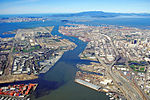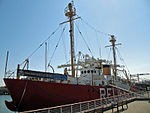Moore Dry Dock Company

Moore Dry Dock Company was a ship repair and shipbuilding company in Oakland, California. In 1905, Robert S. Moore, his brother Joseph A. Moore, and John Thomas Scott purchased the National Iron Works located in the Hunter's Point section of San Francisco, and founded a new company, the Moore & Scott Iron Works Moore had previously been vice president of the Risdon Iron Works of San Francisco. Scott was nephew to Henry T. and Irving M. Scott, owners of the nearby Union Iron Works, where John had risen from apprentice to superintendent. Their new business was soon destroyed by fire resulting from the San Francisco earthquake. They quickly recovered and were back in business before the end of 1906 by purchasing Boole & Sons shipyard on Union Street in Oakland.In 1909, Moore and Scott decided to move across the Bay, and so purchased the W.A. Boole and Son Shipyard, located in Oakland at the foot of Adeline Street along the Oakland Estuary. In 1917, Moore bought out Scott and changed the business name to Moore Shipbuilding Company. The company built a number of United States Shipping Board cargo ships used in World War 1. In 1922, the company name was changed to Moore Dry Dock Company, operating primarily as a repair yard. Its shipbuilding capabilities were expanded in the World War II era, providing over 100 ships for the U.S. Navy and merchant marine. Moore ranked 82nd among United States corporations in the value of World War II military production contracts. Shipbuilding ceased at war's end, but repair operations continued. Moore Dry Dock Company finally closed in 1961. The yard was notable for its employment of several thousand African Americans, in both skilled and unskilled positions, at a time when they confronted major job discrimination. At the Rosie the Riveter/World War II Home Front National Historical Park an inscription honoring the wartime contributions made by the Bay Area Shipyards during World War II states that "Moore Dry Dock handled the difficult jobs of production, repair and conversion that slowed overall output in other yards." In 1950, the Moore facility was the target of a union picket when sailors were having a dispute with a ship owner whose ship was in Moore's dry dock at the time. The court battle which ensued eventually led to the Moore Dry Dock Standards for Primary Picketing at a Secondary Site (Sailors' Union of the Pacific (Moore Dry Dock Co.), 92 NLRB 547, 27 LRRM 1108 (1950)).Moore Dry Dock Company ceased operations in 1961. Its site at the foot of Adeline Street on the Oakland Estuary is now occupied by Schnitzer Steel Industries, a large scrap metal recycling concern, based in Portland, Oregon.
Excerpt from the Wikipedia article Moore Dry Dock Company (License: CC BY-SA 3.0, Authors, Images).Moore Dry Dock Company
Embarcadero West, Oakland
Geographical coordinates (GPS) Address Nearby Places Show on map
Geographical coordinates (GPS)
| Latitude | Longitude |
|---|---|
| N 37.796972222222 ° | E -122.29013888889 ° |
Address
Embarcadero West 1101
94607 Oakland
California, United States
Open on Google Maps








